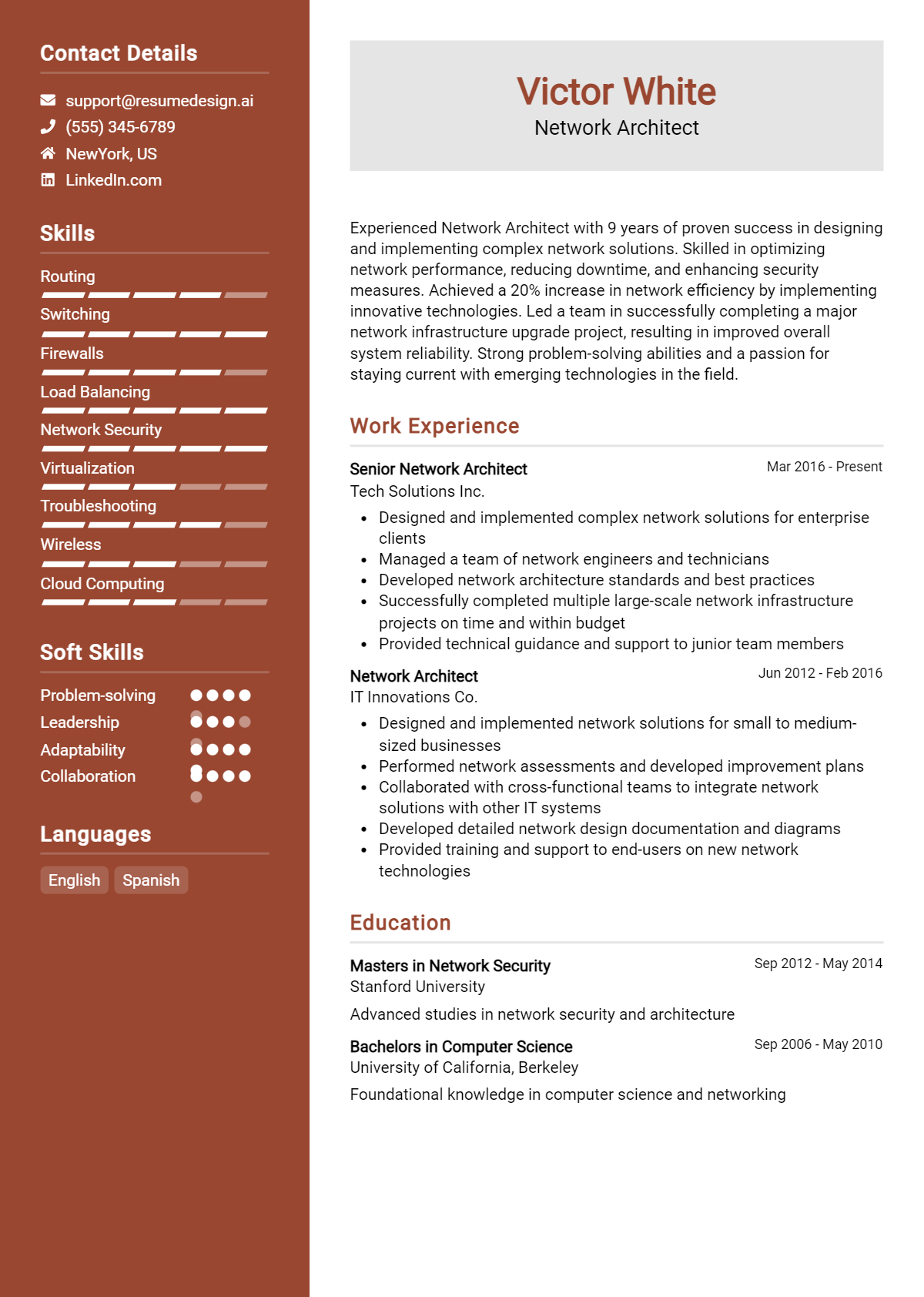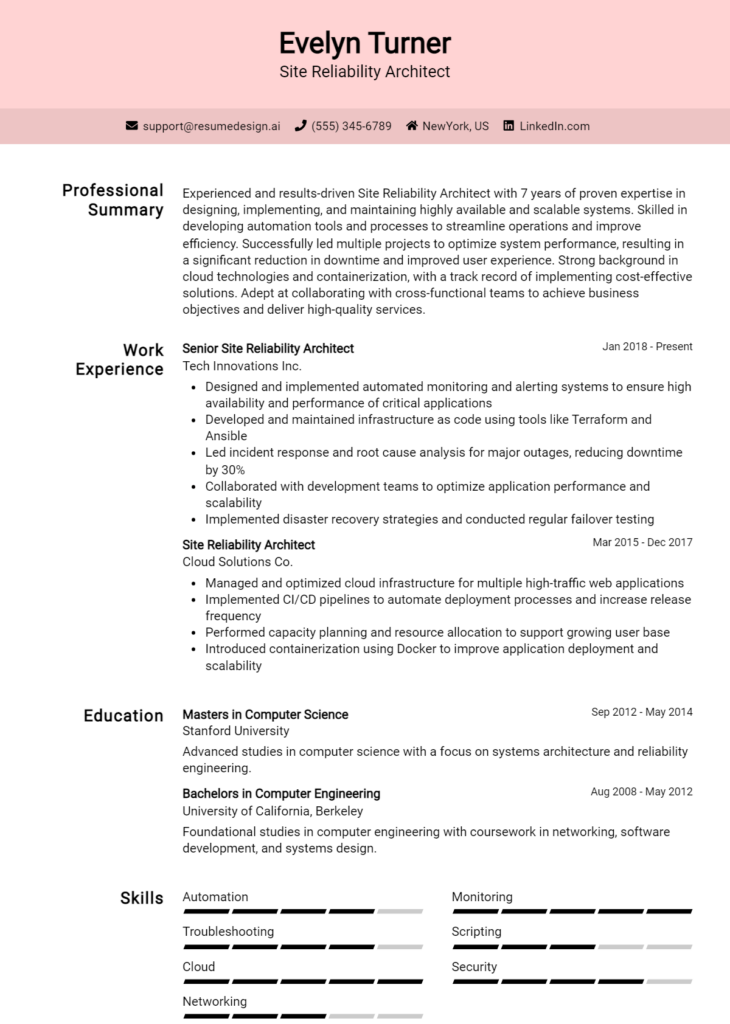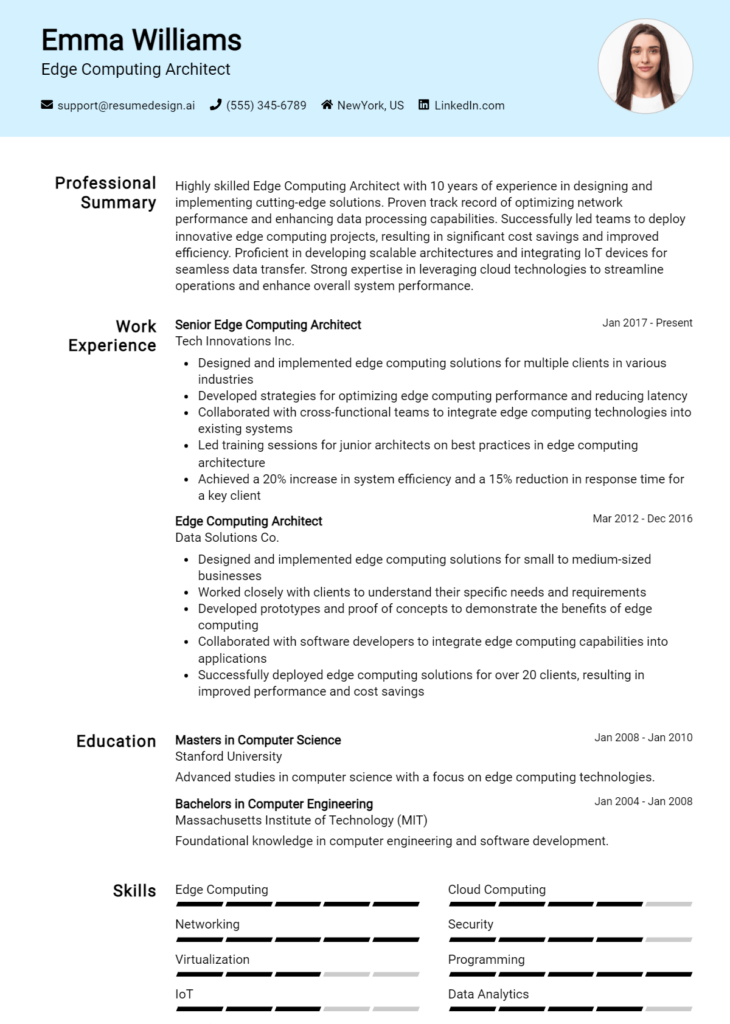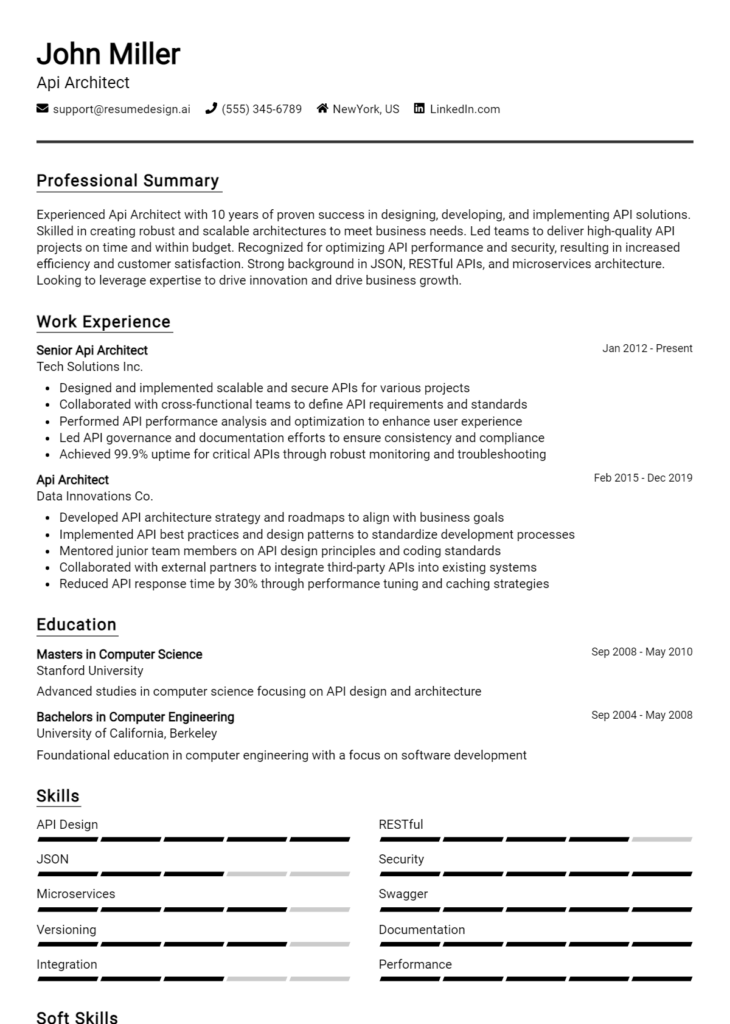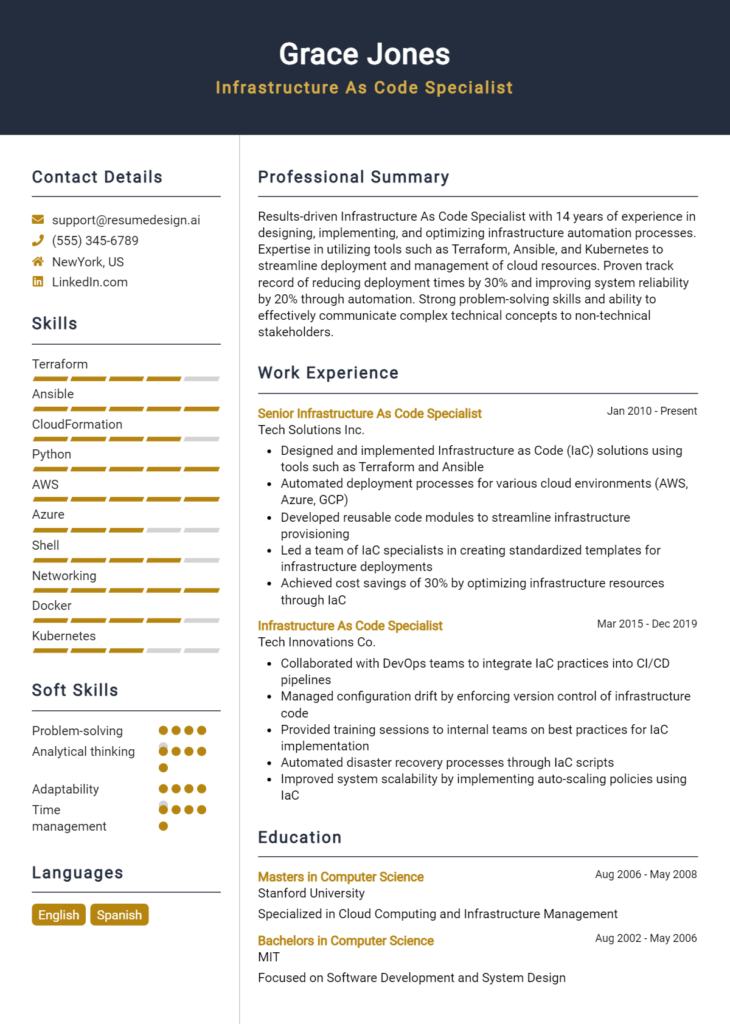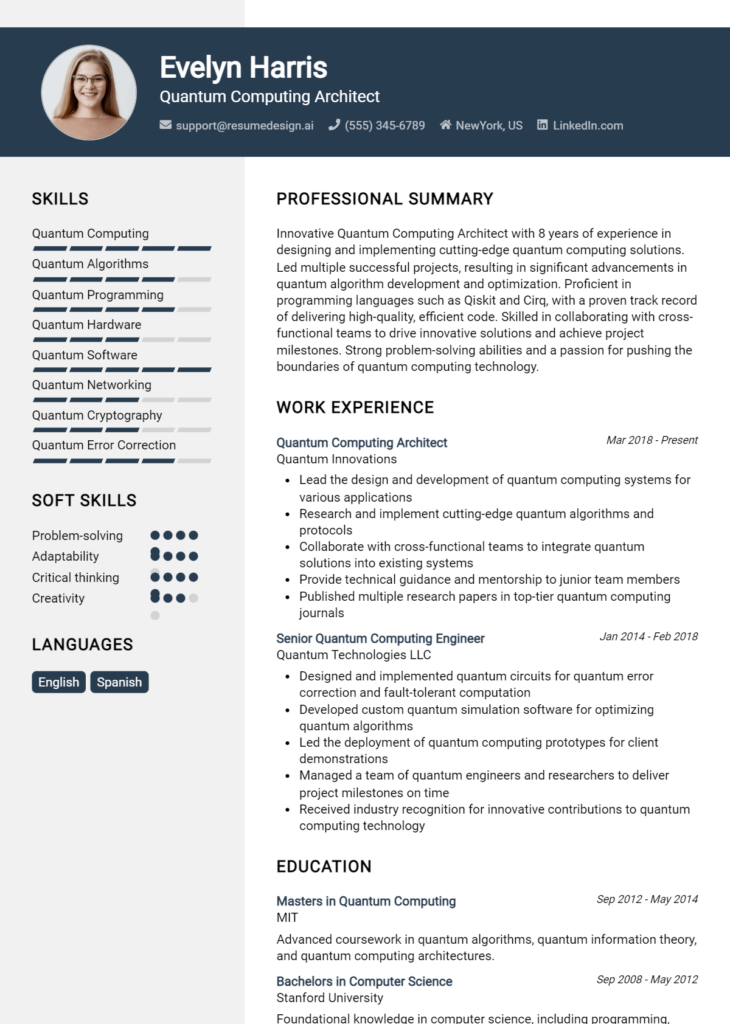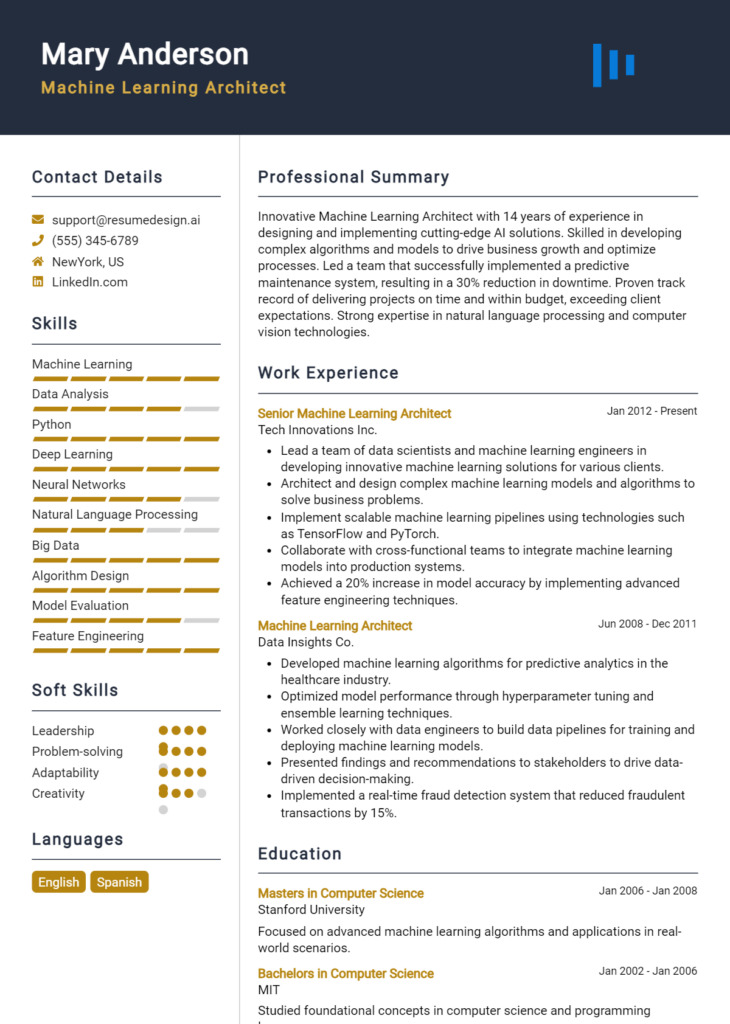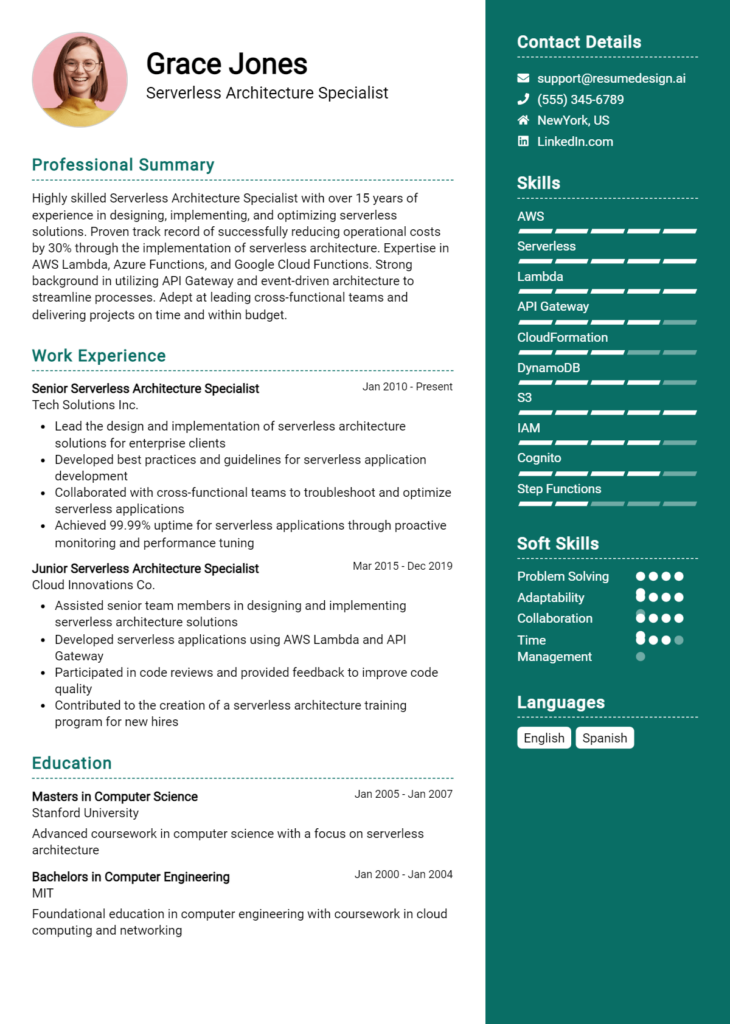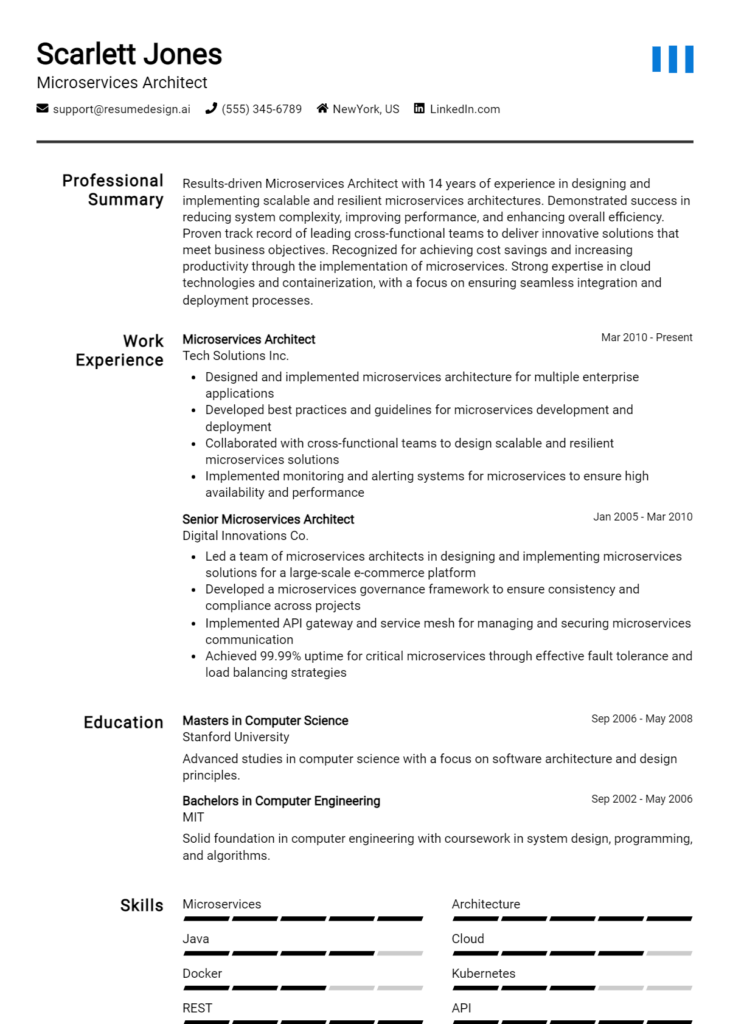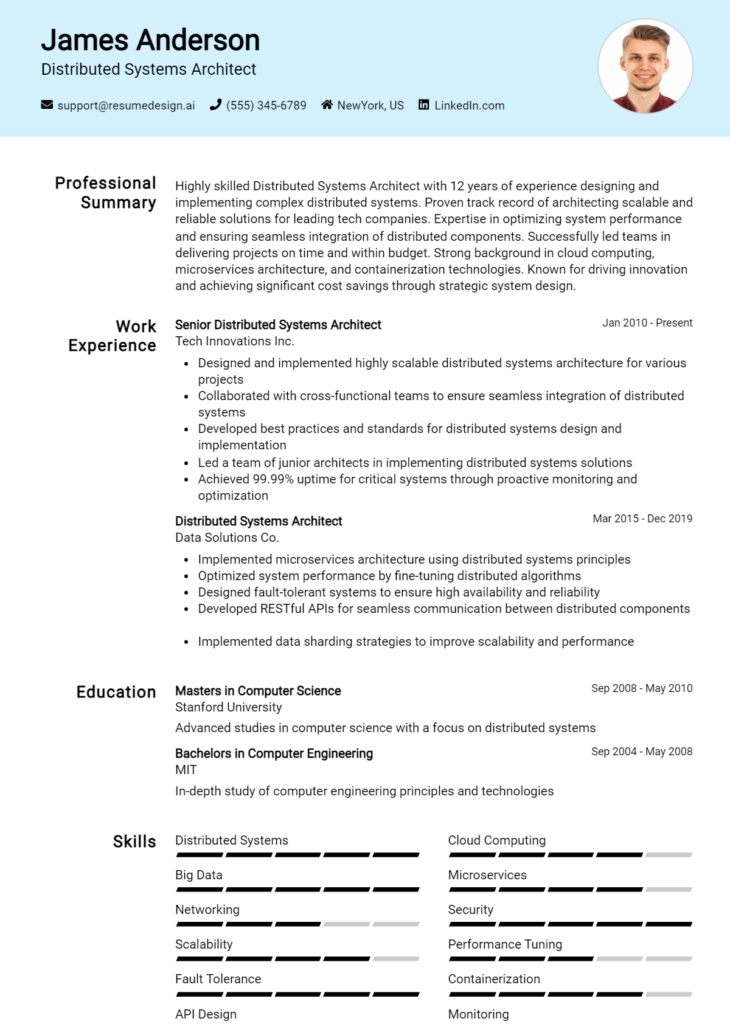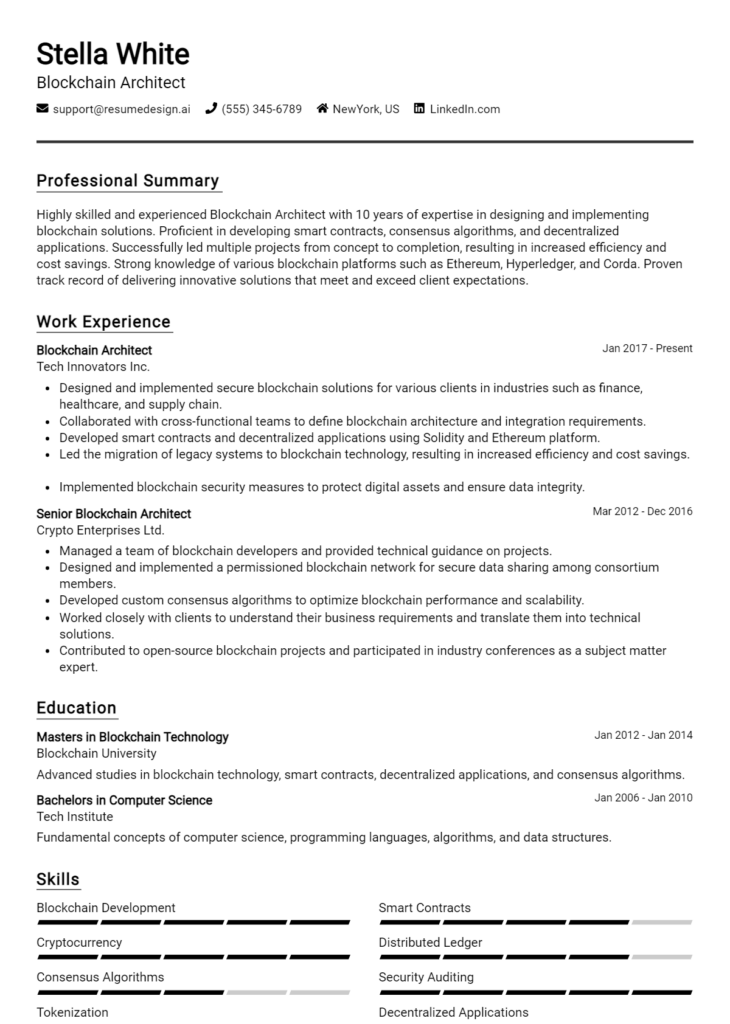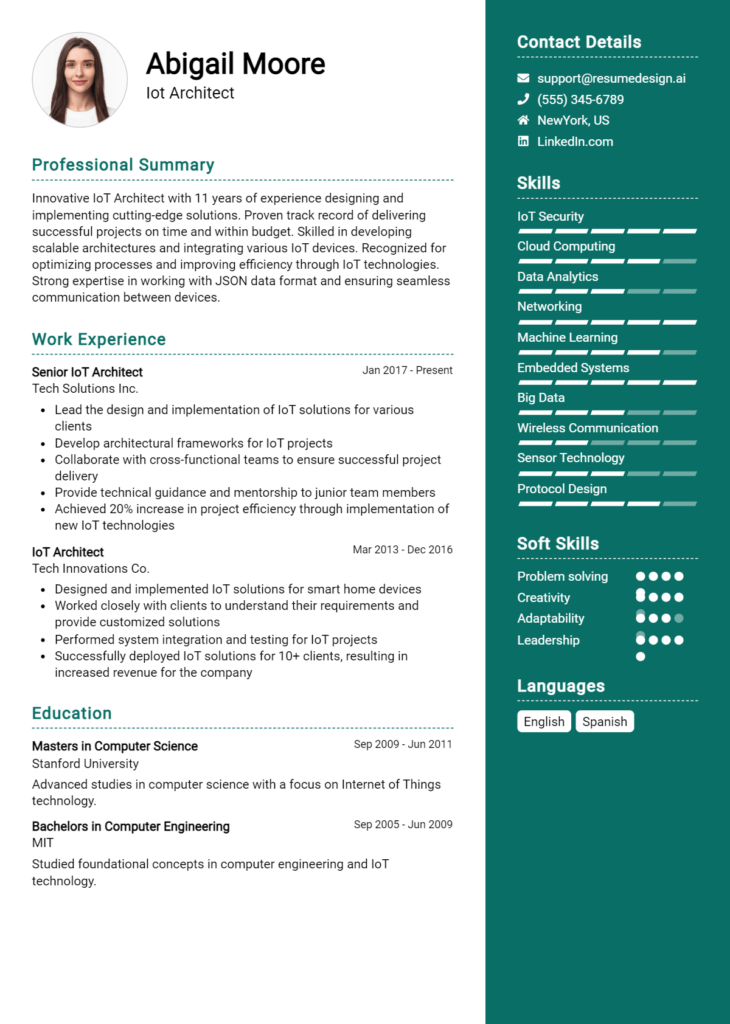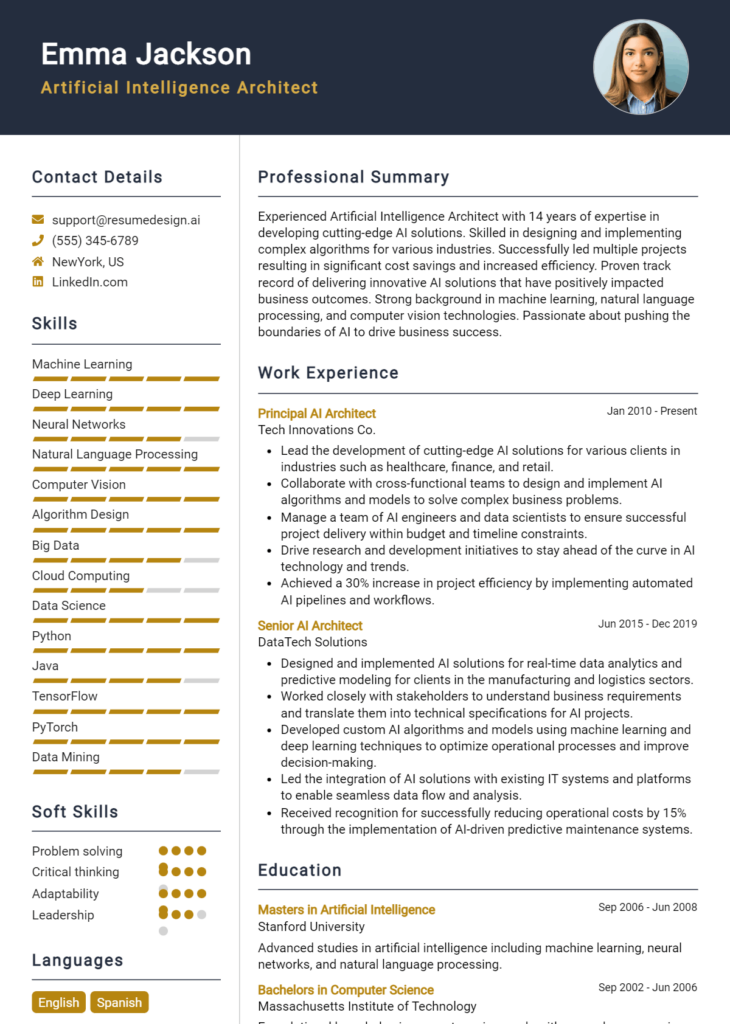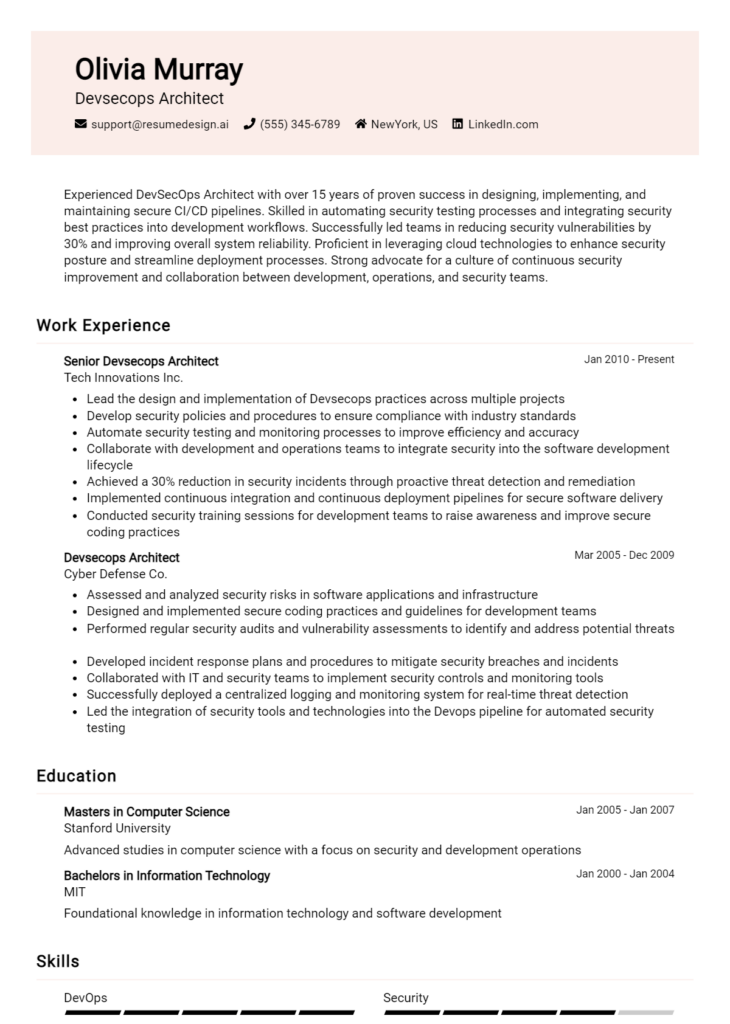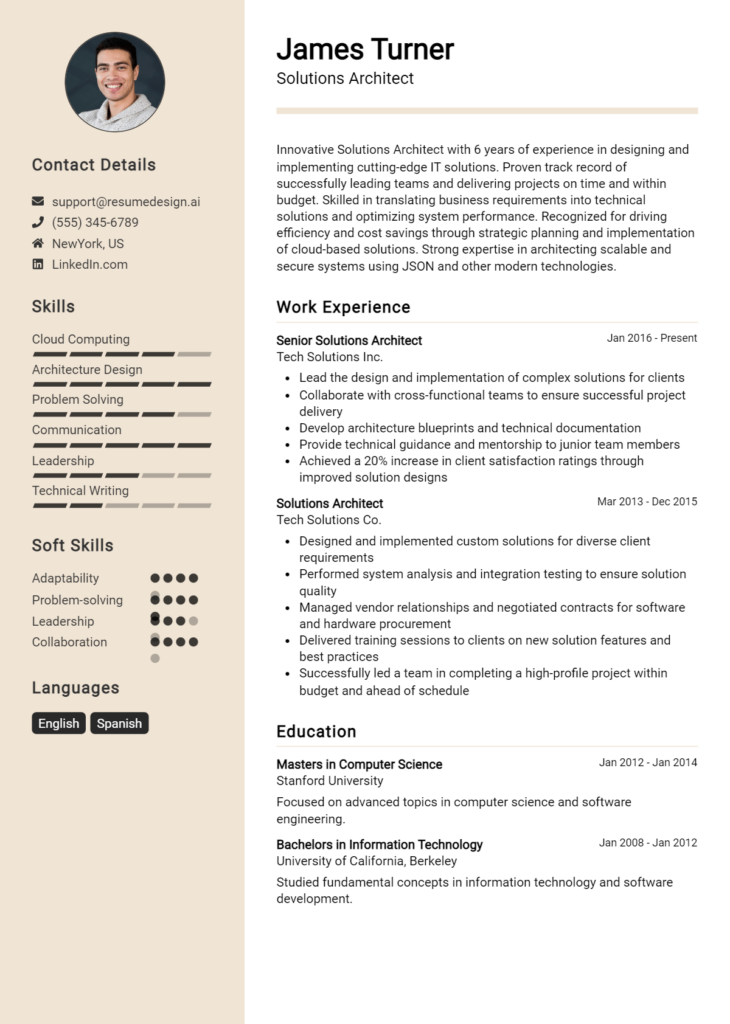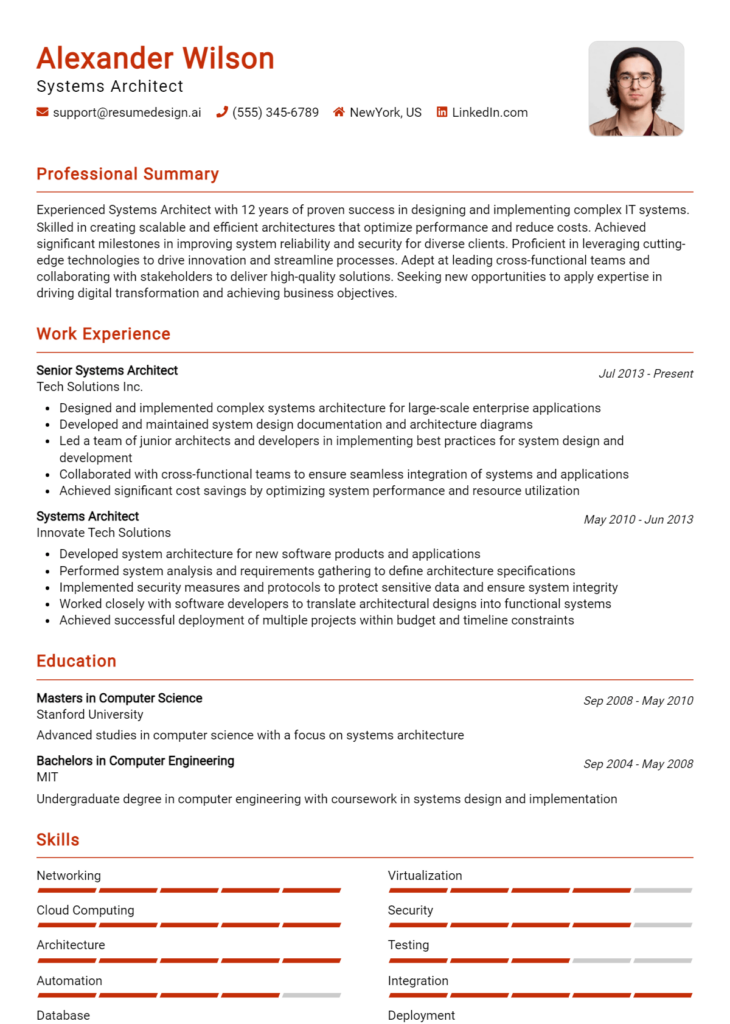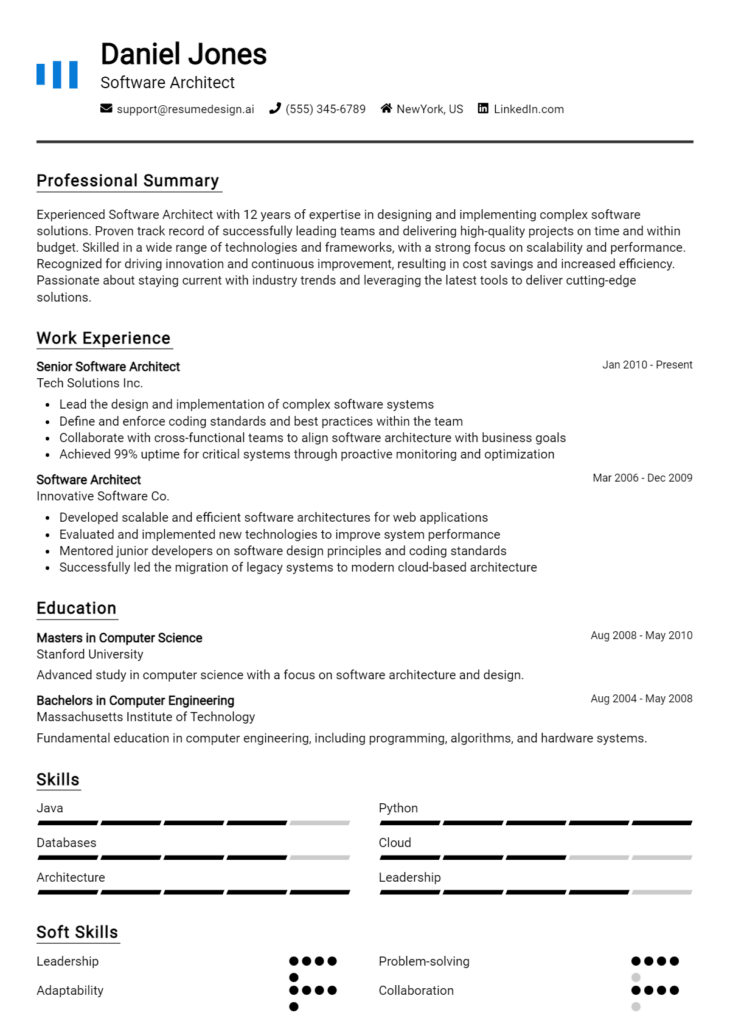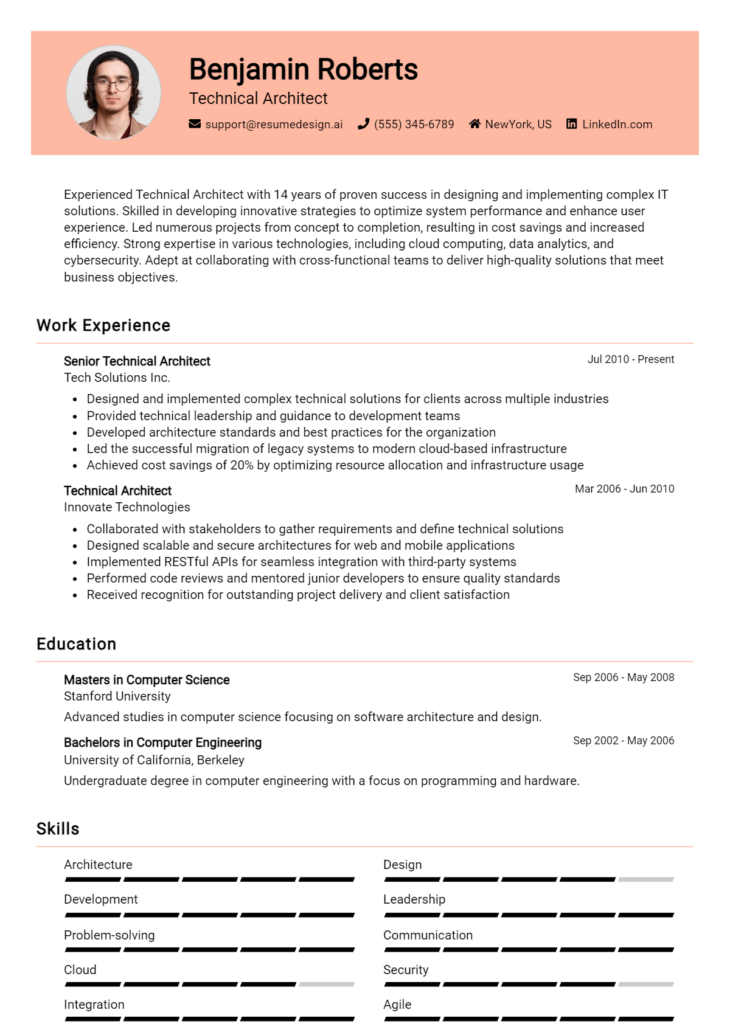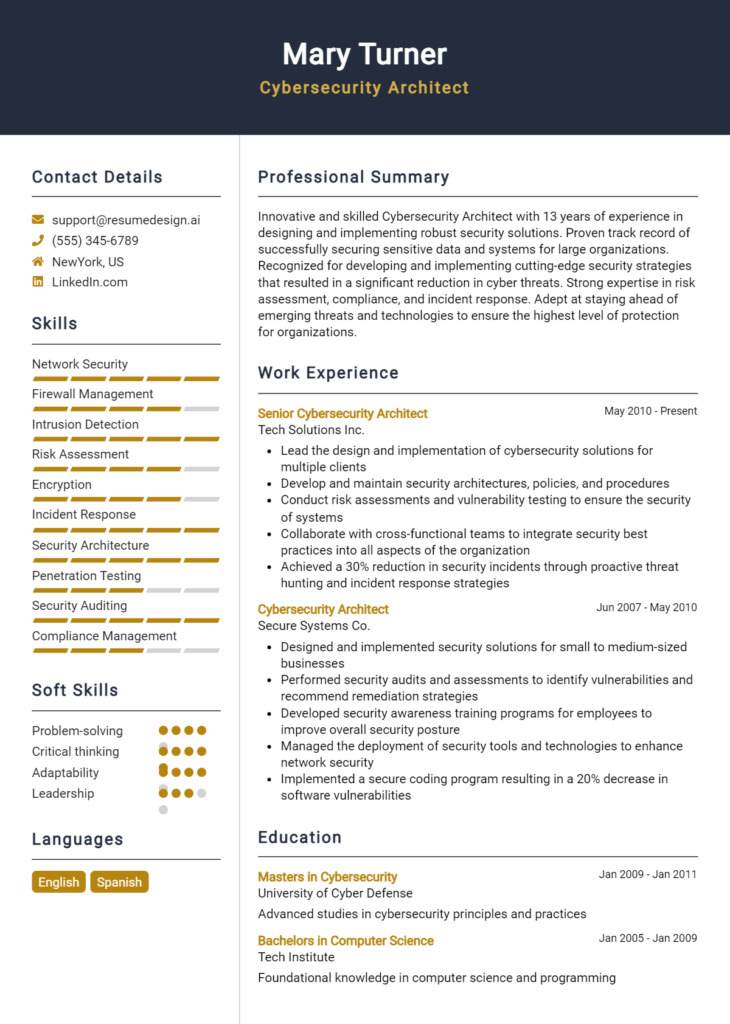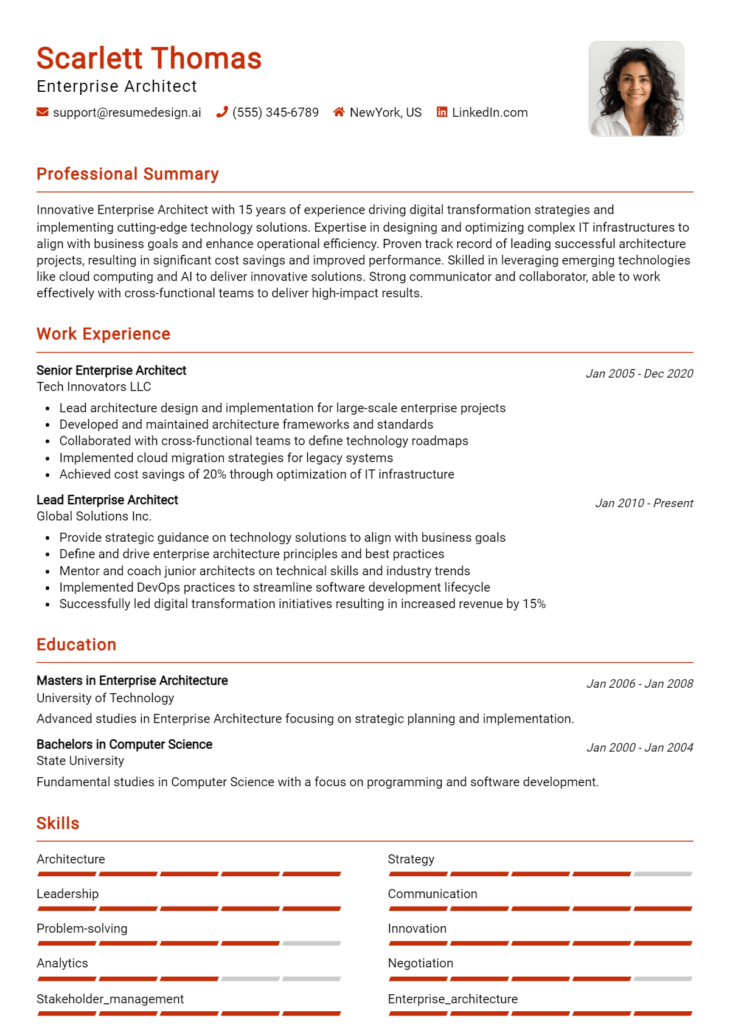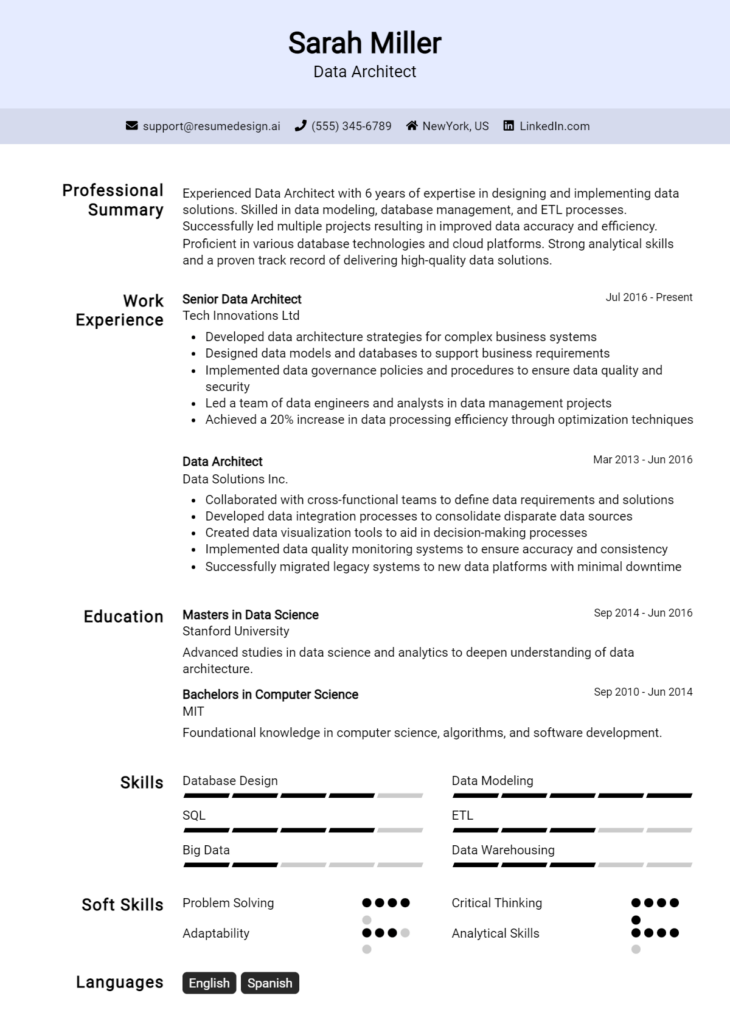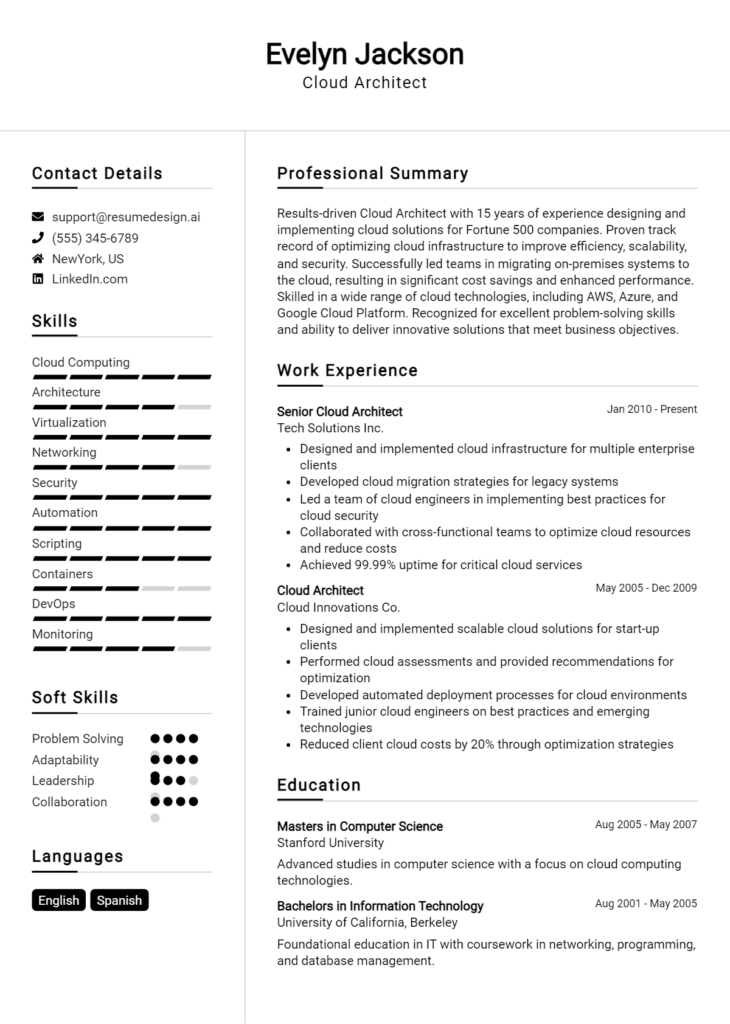Network Architect Core Responsibilities
A Network Architect is pivotal in designing and implementing robust network infrastructures, ensuring seamless connectivity across various departments. Key responsibilities include assessing network requirements, developing strategic plans, and troubleshooting complex issues. Essential skills encompass technical expertise in networking protocols, operational efficiency, and strong problem-solving abilities. These competencies not only enhance departmental collaboration but also align with the organization’s overarching goals. A well-structured resume effectively highlights these qualifications, demonstrating the candidate’s value in a competitive landscape.
Common Responsibilities Listed on Network Architect Resume
- Design and implement network architecture solutions
- Conduct network performance analysis and optimization
- Collaborate with IT teams to integrate new technologies
- Develop and maintain network security protocols
- Manage network infrastructure projects from inception to completion
- Provide technical guidance and support to team members
- Document network configurations, policies, and procedures
- Conduct risk assessments and vulnerability analysis
- Ensure compliance with industry standards and regulations
- Evaluate and recommend hardware and software solutions
- Monitor network performance and troubleshoot issues
- Prepare reports and presentations for stakeholders
High-Level Resume Tips for Network Architect Professionals
In the competitive landscape of technology and networking, a well-crafted resume is essential for Network Architect professionals seeking to make a lasting impression on potential employers. Your resume often serves as the first point of contact between you and hiring managers; it reflects your skills, accomplishments, and unique contributions to the field. It’s crucial that it not only highlights your technical expertise but also showcases your ability to design and implement complex network solutions. This guide will provide practical and actionable resume tips specifically tailored for Network Architect professionals, helping you stand out in a crowded job market.
Top Resume Tips for Network Architect Professionals
- Tailor your resume to each job description, emphasizing relevant skills and experiences that align with the specific requirements of the role.
- Use clear and concise language to describe your previous positions, focusing on responsibilities that relate directly to network architecture.
- Quantify your achievements with metrics where possible, such as the size of networks managed, percentage improvements in network efficiency, or cost savings generated.
- Highlight industry-specific skills, such as proficiency in protocols (like TCP/IP, OSPF, BGP), and technologies (like Cisco, Juniper, SD-WAN) relevant to the job.
- Include relevant certifications (e.g., CCNA, CCNP, JNCIE) prominently to demonstrate your commitment to professional development and expertise in the field.
- Showcase your problem-solving abilities and successful project implementations, detailing your role in overcoming challenges in network design and management.
- Incorporate keywords from the job description to optimize your resume for Applicant Tracking Systems (ATS) and ensure it gets noticed.
- Utilize a clean, professional format that makes it easy for hiring managers to quickly scan and find key information.
- Consider including a summary statement at the top of your resume that encapsulates your experience and career goals in network architecture.
By implementing these tips, you can significantly enhance your resume's effectiveness, increasing your chances of landing a job in the Network Architect field. A well-structured resume that clearly communicates your skills and achievements can set you apart from other candidates and draw the attention of prospective employers.
Why Resume Headlines & Titles are Important for Network Architect
In the competitive field of network architecture, a well-crafted resume headline or title is crucial for making a lasting first impression. A strong headline can immediately capture the attention of hiring managers, providing a concise summary of a candidate's key qualifications in just a few impactful words. This not only sets the tone for the rest of the resume but also helps to differentiate a candidate from others vying for the same position. An effective resume headline should be concise, relevant, and directly aligned with the specific job being applied for, ensuring that it resonates with the expectations of potential employers.
Best Practices for Crafting Resume Headlines for Network Architect
- Keep it concise: Aim for a headline that is brief yet impactful, ideally one line.
- Make it role-specific: Tailor the headline to reflect the specific network architect position you are applying for.
- Highlight key skills: Include core competencies that are relevant to the role, such as network design or cybersecurity.
- Include years of experience: If applicable, mention the number of years you have worked in the field to demonstrate your expertise.
- Use strong action words: Begin with powerful verbs that convey your capabilities, such as "Expert" or "Certified."
- Avoid jargon: Ensure the language is clear and understandable to a broader audience, not just technical peers.
- Showcase achievements: If space allows, include a notable accomplishment that illustrates your value.
- Stay relevant: Regularly update your headline to reflect any new skills or experiences pertinent to current job trends.
Example Resume Headlines for Network Architect
Strong Resume Headlines
"Certified Network Architect with 10+ Years of Experience in Designing Scalable Solutions"
“Strategic Network Architect Specializing in Cybersecurity and Cloud Integration”
“Results-Driven Network Architect with Proven Success in Large-Scale Deployments”
Weak Resume Headlines
“Network Professional”
“Experienced Engineer”
Strong headlines are effective because they clearly articulate the candidate's unique strengths and qualifications, thereby making a powerful statement about their suitability for the role. They are specific, providing insight into the candidate's skills and experience, which helps hiring managers quickly recognize their potential fit for the position. In contrast, weak headlines fail to impress due to their vagueness and lack of specificity, leaving hiring managers uncertain about the candidate's qualifications or relevance to the role they are applying for. By avoiding generic language and honing in on specific expertise, candidates can significantly enhance their chances of standing out in a crowded job market.
Writing an Exceptional Network Architect Resume Summary
A well-crafted resume summary is a critical component for a Network Architect as it serves as the first impression to hiring managers. In a competitive job market, a strong summary quickly captures attention by succinctly showcasing key skills, relevant experience, and notable accomplishments. It should convey the candidate's unique value proposition, highlighting expertise in network design, implementation, and management, while aligning closely with the specific job requirements. An impactful resume summary is concise, engaging, and tailored to reflect the demands of the position, thereby increasing the chances of securing an interview.
Best Practices for Writing a Network Architect Resume Summary
- Quantify Achievements: Use numbers and data to demonstrate the impact of your work, such as reduced downtime or improved network efficiency.
- Focus on Relevant Skills: Highlight technical skills specific to network architecture, such as proficiency in routing protocols, security measures, and cloud networking.
- Tailor the Summary: Customize the summary for each application to match the job description, emphasizing the most relevant experience and skills.
- Keep it Concise: Aim for 2-4 sentences that clearly articulate your professional strengths without overwhelming the reader.
- Use Strong Action Verbs: Begin sentences with powerful verbs to convey confidence and capability, such as "designed," "implemented," or "optimized."
- Highlight Certifications: Include any relevant certifications (e.g., CCNP, CCIE) that validate your expertise in network architecture.
- Showcase Soft Skills: Mention interpersonal skills like teamwork, communication, or project management that complement your technical abilities.
- Reflect Industry Trends: Incorporate knowledge of current technologies and trends in network architecture to position yourself as a forward-thinking candidate.
Example Network Architect Resume Summaries
Strong Resume Summaries
Dynamic Network Architect with over 8 years of experience in designing and implementing robust network infrastructures. Successfully reduced system downtime by 30% through strategic upgrades and proactive monitoring, ensuring seamless connectivity for over 500 users.
Results-driven Network Architect skilled in cloud solutions and cybersecurity, with a proven track record of managing enterprise-level networks. Spearheaded a project that enhanced network performance by 25%, leading to a significant boost in operational efficiency.
Innovative Network Architect with expertise in implementing SD-WAN solutions, achieving a 40% reduction in operational costs. Enhanced network security protocols that led to a 50% decrease in vulnerabilities, safeguarding sensitive data across the organization.
Accomplished Network Architect with 10+ years in designing scalable networks for multinational corporations. Championed a network redesign that improved response time by 60%, resulting in higher customer satisfaction and retention rates.
Weak Resume Summaries
Network Architect with several years of experience in networking. I have worked on various projects and know a lot about different technologies.
Experienced professional looking for a new opportunity in network architecture. I am good at solving problems and have worked in IT for a long time.
The examples of strong resume summaries are considered effective because they are specific, quantify achievements, and directly relate to the role of a Network Architect. They illustrate the candidate's impact on previous employers, showcasing measurable results and relevant skills. In contrast, the weak summaries are vague and general, lacking any concrete examples or quantifiable outcomes, which diminishes their effectiveness in capturing the attention of hiring managers.
Work Experience Section for Network Architect Resume
The work experience section of a Network Architect resume is crucial as it serves as a compelling narrative of the candidate's professional journey, illustrating their technical abilities, leadership skills, and capability to deliver high-quality network solutions. This section not only highlights the candidate's proficiency in designing and implementing complex networks but also emphasizes their experience in managing teams and projects. By quantifying achievements, such as improvements in network performance or cost savings, and aligning their experiences with industry standards, candidates can significantly enhance their appeal to potential employers.
Best Practices for Network Architect Work Experience
- Emphasize relevant technical skills and certifications, such as CCNP, CCIE, or cloud architecture expertise.
- Quantify achievements with specific metrics, such as increased network efficiency by X% or reduced downtime by Y hours.
- Highlight experiences that demonstrate leadership in team projects and cross-department collaborations.
- Tailor the work experience to match the job description, emphasizing skills and experiences that align with the role.
- Use action verbs to convey impact, such as "designed," "implemented," "optimized," and "led."
- Detail the technologies and methodologies employed in each role to demonstrate depth of knowledge.
- Include successful project outcomes, such as on-time delivery of network solutions or achievement of specific service level agreements (SLAs).
- Showcase problem-solving abilities by detailing challenges faced and innovative solutions implemented.
Example Work Experiences for Network Architect
Strong Experiences
- Designed and implemented a scalable enterprise network infrastructure that improved data transfer speeds by 30%, resulting in enhanced team productivity.
- Led a cross-functional team in migrating a legacy system to a cloud-based architecture, achieving a 40% reduction in operational costs and increasing system availability by 99.9%.
- Developed and executed a comprehensive network security strategy that reduced security breaches by 50% over two years, ensuring compliance with industry regulations.
- Collaborated with software development and IT operations teams to integrate DevOps practices, leading to a 25% increase in deployment efficiency.
Weak Experiences
- Worked on network projects with little detail about the specific contributions or outcomes.
- Assisted in various tasks related to network architecture without clearly defining the impact of those tasks.
- Involved in team meetings to discuss network issues, but did not specify any resolutions or changes made.
- Helped manage a few projects, but did not provide any data on performance improvements or deliverables.
The examples provided demonstrate the stark contrast between strong and weak experiences. Strong experiences are characterized by clear quantifiable outcomes, specific technical achievements, and evidence of leadership and collaboration. These statements effectively convey the candidate's capability to deliver value and lead projects. In contrast, weak experiences lack detail, specificity, and measurable results, making it difficult for potential employers to assess the candidate's true impact and expertise in the field of network architecture.
Education and Certifications Section for Network Architect Resume
The education and certifications section of a Network Architect resume is vital as it serves as a testament to the candidate's academic achievements, industry-relevant certifications, and commitment to continuous learning. This section not only showcases the foundational knowledge acquired through formal education but also highlights specialized training and certifications that are crucial in the ever-evolving field of networking. By detailing relevant coursework and certifications, candidates can enhance their credibility and demonstrate their alignment with the specific demands of the Network Architect role, making them more appealing to potential employers.
Best Practices for Network Architect Education and Certifications
- Focus on relevant degrees such as Computer Science, Information Technology, or Network Engineering.
- Include industry-recognized certifications like Cisco CCNP, CCIE, or CompTIA Network+.
- Highlight any specialized training programs that align with current technologies and networking practices.
- List relevant coursework that pertains to network design, security, and architecture.
- Keep the information concise and directly related to the role of a Network Architect.
- Update the section regularly to include new certifications or courses completed.
- Mention any professional development activities, such as workshops or conferences attended.
- Consider including honors or awards received in relevant academic or professional settings.
Example Education and Certifications for Network Architect
Strong Examples
- Bachelor of Science in Computer Science, XYZ University, Graduated May 2020
- Cisco Certified Network Professional (CCNP) - Achieved September 2022
- Mastering Network Security - Online Course, Coursera, Completed January 2023
- Certified Information Systems Security Professional (CISSP) - Achieved March 2023
Weak Examples
- Associate Degree in General Studies, ABC Community College, Graduated June 2018
- CompTIA A+ Certification - Expired June 2021
- Certificate in Microsoft Office - Completed July 2020
- Bachelor of Arts in History, XYZ University, Graduated May 2019
The examples provided showcase a clear distinction between strong and weak qualifications. Strong examples are relevant and up-to-date, aligning directly with the skills and knowledge necessary for a Network Architect role. They demonstrate a focus on networking and security, thereby enhancing the candidate's profile. Conversely, weak examples reflect irrelevant or outdated qualifications that do not contribute to the candidate's expertise in networking, potentially undermining their credibility in the field.
Top Skills & Keywords for Network Architect Resume
In the competitive field of network architecture, showcasing the right skills on your resume is crucial for standing out to potential employers. A well-crafted resume not only highlights your technical expertise but also reflects your ability to collaborate effectively, solve complex problems, and adapt to evolving technologies. By emphasizing both hard and soft skills, you communicate your comprehensive understanding of network systems and your capability to work within a team environment. The balance of these skills can significantly enhance your appeal to hiring managers, making it essential to curate them thoughtfully.
Top Hard & Soft Skills for Network Architect
Soft Skills
- Communication
- Problem-solving
- Team collaboration
- Critical thinking
- Adaptability
- Attention to detail
- Project management
- Time management
- Creativity
- Leadership
Hard Skills
- Network design and implementation
- TCP/IP protocols
- Routing and switching
- Firewall and security protocols
- Virtualization technologies
- Cloud computing
- Network monitoring tools
- VPN configuration
- Load balancing
- Disaster recovery planning
For a more in-depth understanding of how to present these skills and your work experience, ensure that each skill is backed by relevant examples from your professional background. This approach will not only strengthen your resume but also prepare you for discussions during interviews.
Stand Out with a Winning Network Architect Cover Letter
Dear [Hiring Manager's Name],
I am writing to express my interest in the Network Architect position at [Company Name], as advertised on [where you found the job listing]. With over [X years] of experience in designing and implementing robust network infrastructures, I am confident in my ability to contribute effectively to your team. My expertise in both enterprise-level networking solutions and cloud technologies has prepared me well for the challenges presented in today’s dynamic IT landscape.
In my previous role at [Previous Company Name], I successfully led a project that revamped our network architecture, resulting in a 30% increase in efficiency and a significant reduction in downtime. My proficiency in network design principles, coupled with my hands-on experience with various protocols and technologies, enabled me to develop scalable solutions tailored to meet the unique requirements of our clients. I am particularly proud of my ability to collaborate cross-functionally with stakeholders to ensure alignment with business objectives while maintaining a focus on cybersecurity best practices.
I am excited about the opportunity to bring my skills in network optimization and strategic planning to [Company Name]. I am particularly impressed by [specific project or achievement of the company], and I believe my background in [specific technology or methodology] will allow me to make valuable contributions to your ongoing initiatives. I look forward to the possibility of discussing how my experience and vision align with the goals of your organization.
Thank you for considering my application. I hope to speak with you soon about how I can contribute to the innovative work at [Company Name].
Sincerely,
[Your Name]
[Your LinkedIn Profile]
[Your Contact Information]
Common Mistakes to Avoid in a Network Architect Resume
When crafting a resume as a Network Architect, it's crucial to present your skills and experiences in a clear and impactful manner. However, many candidates fall into common pitfalls that can detract from the professionalism and effectiveness of their application. Avoiding these missteps can significantly enhance your chances of standing out in a competitive job market. Below are some frequent mistakes to steer clear of when writing your Network Architect resume:
Lack of Specificity: Using vague language can make your accomplishments sound less impressive. Instead of saying "worked on network projects," specify the type of projects and your role in them.
Ignoring Keywords: Failing to include relevant industry keywords can lead to your resume being overlooked by applicant tracking systems (ATS). Research job descriptions and incorporate essential terms related to networking technologies and frameworks.
Overloading with Technical Jargon: While it's important to demonstrate technical expertise, overwhelming the reader with jargon can alienate those not familiar with specific terms. Balance technical language with clear explanations.
Neglecting Soft Skills: Network Architects need strong communication and collaboration skills. Focusing solely on technical skills might make you seem one-dimensional. Highlight your ability to work with teams and communicate complex concepts.
Inconsistent Formatting: A disorganized or inconsistent format can make your resume difficult to read. Use uniform fonts, headings, and bullet points to create a polished and professional appearance.
Listing Responsibilities Instead of Achievements: Simply outlining job duties does not showcase your impact. Focus on quantifiable achievements, such as "reduced network downtime by 30%" to demonstrate your effectiveness.
Omitting Relevant Certifications: Certifications like CCNP, CCIE, or AWS Certified Solutions Architect are critical in this field. Ensure these credentials are prominently featured to validate your expertise.
Not Tailoring the Resume: Sending a generic resume to multiple employers can be detrimental. Customize your resume for each application to align with the specific requirements and culture of the organization.
Conclusion
As we've explored the essential skills and responsibilities of a Network Architect, it’s clear that this role is pivotal in designing and maintaining robust network infrastructures. A successful Network Architect must possess a deep understanding of network design principles, proficiency in various networking technologies, and the ability to collaborate with other IT professionals to deliver optimal solutions. Additionally, staying updated with the latest trends and advancements in networking is crucial for continuous improvement and adaptation in this fast-evolving field.
In conclusion, if you aspire to excel as a Network Architect, it's vital to ensure that your resume effectively showcases your expertise and accomplishments. Take the time to review and refine your resume to highlight your relevant skills and experiences. To assist you in this process, consider utilizing available resources such as resume templates, a user-friendly resume builder, and resume examples that can inspire and guide your writing. Additionally, don’t forget to craft a compelling cover letter using cover letter templates that complement your resume.
Act now and take the first step toward enhancing your professional presentation!

